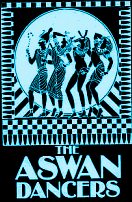
SOMETHING CRASHED AND I BELONG TO THE DINOSAUR AGE
SO I AM CONTINUING JANUARY'S BLOG BELOW.
January 31, 2012
Faiza Ahmed and Mohamed Sultan

Tonight we danced to music for Faiza Ahmed (1934-1983). She was
Syrian/Lebanese, but after moving to Egypt and eventually marrying Mohamed
Sultan, she became Egyptian. She acted and sang in the movie Tammer
Henna with Naima Akef.
Two of my favorite songs - yes I have lots of favorites - is "Ana
Albi Aleik Mayel" composed by Mohamed el Mougy who also
composed for Om and Abdel Halim and "Khaliku Shahedeen"
composed by her husband Mohamed Sultan.
Her husband, Mohamed Sultan, composed many of the songs she sang. They
are very danceable as was discovered by dancers Mona Said, Nagwa Fouad,
Amani and Dina and other dancers in the West as well.
Leila
One dancer who really seems to enjoy his music is Leila Haddad, Tunisian dancer who lives in France. Her husband Biram produced two CD albums devoted to Mohamed Sultan's music for Leila. She will be coming to San Francisco soon as she is part of the Rakassah tradition. When she comes she usually wants to see an "exposition" so we go to the museums. I wonder what exhibits will be of interest this time. She also usually buys a suitcase full of books. I often wonder if she sees Rakassah as an excuse to shop in San Francisco.
One very well known Mohamed Sultan dance song is "Sitt el Hosn"
composed for Nagwa. It was also redone as raqs sharqi on "Setrak
Volume 12". It's pretty powerful and very exciting to dance to.
I call it Yes No Yes, Yes No No because in the beginning, the repeats
with the drum breaks go - yes drum, no drum, yes drum, yes drum, no drum
no drum. I get confused unless I repeat that to myself before dancing
to it. I've also seen drummers here get confused. Maybe this doesn't make
sense to you, but if you listen to the music and repeat after me - yes
no yes, yes no no while dancing the opening, maybe it will make sense.
Tonight I played "Aywa
Taabni Hawak". Last night I played "Ahla
Tariq fee Duniyati". Both of these songs are very danceable.
In fact, the you tube clip I posted for "Ahla Tariq" is really
quite nice. I hope you watch it. I'm hoping to get the band to work on
these two pieces so we can have more dance music available that isn't
so overused. Home
January 30, 2012
Tara Sufiana
Today I received a book I ordered from Amazon. Bettina Robbi now
known as Tara Sufiana wrote it. The book, "The Sword and
the Rose" A Swiss-American Dervish in Egypt, is the story of
Tara's adventures in Egypt. I knew her as
Bettina and she was my first belly dance teacher.
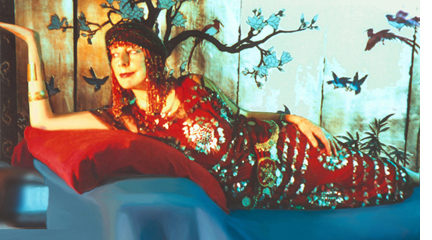
A couple of years ago, after 40 or so years, I received an email from
Bettina telling me a bit about her life and that she had written a book.
She told me that she found me on the Internet. I guess computers are good
for something. Somehow as things go, her email got lost in my queue and
finding the book remained in my "to buy" list.
Last week someone contacted me wanting to know if I had Bettina's address.
So --- I looked for it, found it, sent off the information and decided
to purchase this book and find out what happened to my teacher after she
moved from San Francisco. After all, although she didn't and doesn't know
it, she was responsible for the rest of my life since 1965.
The book arrived today and I barely had time to check it out, but am looking
forward to start reading it from page 1. It looks like one of those books
- especially since I knew her - which I will not put down. Bettina/Tara
was a real character when I knew her, and as I quickly leafed through
the pages this morning, it seems that she still is.
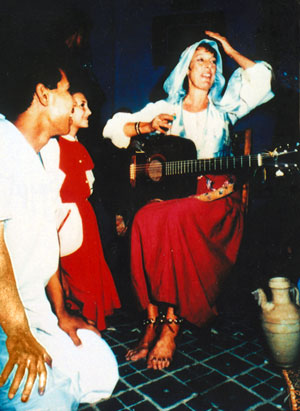
Below is a short blurb describing her adventures:
"An unplanned adventure finds Tara Sufiana amidst the Sufis of Egypt
for five years. Immersed in their mystical practices, she discovers the
Dervish within, expressing herself through sacred dance and music at religious
festivals throughout Egypt. Within the Sufi enclave, an unusual love story
with a dervish Sheikh unfolds. When not roaming with the Sufis, or off
on her own wild escapades, Tara survives by singing and dancing for hotels,
cruise ships, folkloric shows, TV and films, crowned by a dance on top
of the Great Pyramid. The rich culture of a Middle Eastern society is
revealed throughout this amazing odyssey.
Born in Switzerland of a Swiss father and American mother, Tara Sufiana
has lived most of her life in the United States with extended travels
in 30 countries. Her professions include flamenco dancing, singing, modeling,
belly dancing, acting, and writing. Tara's articles have been published
in leading magazines in four countries. She conducts workshops in Egyptian
Dervish Dance internationally. Although she holds university degrees in
Psychology and India Studies, Tara gathers a wealth of knowledge through
personal experience. When not traveling, she resides in her mountain home
in northern California."
Reading paragraphs here and there throughout the book, the above pr blurb
does not do justice to her stories and misadventures. I need to start
this book immediately. After I finish reading it, I think I will contact
her and tell her how she unknowingly changed my life. She is the free
spirit that I wish I could be and just reading the few bits I did read
brought back so many memories of her including a wild Halloween party
she had at her flat on Leavenworth St. That party where she was dressed
as Cleopatra was only a preview of the adventures that were waiting for
her in Egypt. And for me it was a preview of the life I was going to lead
here in San Francisco. Thanks to Bettina or Tara Sufiana tonight I taught
belly dance classes.
Lessa Faker - Do you still remember?
Om Kalthoum
lessa - still
faker - remember
albi - my heart
kilma - a word
nazra - a look
shouq, shou' - longing, yearning
walla - or not
kan - kan - past tense
kan zaman=once a upon a time in the past Home
January 29 2012
Where's the soy sauce?
Decisions. I hope I made the right ones. Today the Pasha Band was
to play for a birthday party at a yacht club in San Rafael. But all the
members of the Pasha Band belong to Aswat and Aswat was having
its first rehearsal in Oakland with Omar Abbad our visiting director
from Jordan. Both of these events were to end about 6 pm, which was good
because I was supposed to accompany Mohamed Amin (who plays keyboard
and nai) on percussion at Al Masri at 7:30 in San Francisco. Since
the Pasha Band is a group and we practice together as a group, I wanted
to join them but - What to do? Pasha Band or Aswat practice. Well, Nabila,
our leader from Aswat, gave her blessings to the whole group with a reminder
that we have Aswat rehearsal on Wednesday. So, we missed the first practice
but we surely won't miss Wednesday's.
Susu brought a couple of Moroccan bendirs to the yacht club party and after sound check we spent some time practicing Moroccan songs and rhythms with Younes. We are determined to be a well-rounded, versatile band playing music from all over the Arab world plus Turkey and Iran. Last summer, before we "officially" formed this band, Susu, Husain, Jalal and I played at The Real Doner on Saturday nights. Sometimes other percussionists joined in - Linda, Sandy, Yousef Mustafa, Mark Bell and even Vince Delgado. The Real Doner is a Turkish cafe/restaurant in Petaluma with indoor/outdoor seating. So during the summer months we played for Meteh, a Turkish singer and belly dancers Terri Anne, Ozlem, Radha and Teresa. Jalal and Meteh gave us practice CDs so we at least could know the popular Turkish songs. Now, as the Pasha band with the addition of Younes from Morocco, it's time to add more music and songs. It's also really great that all these guys have a willingness to rehearse besides just showing up for a show. An example - Husain, Younes and I carpooled to San Rafael - yes, we traveled in style, in a limo of course - and they decided to play our practice CD with all the dance mergence's: Princess, Banat, Mashaal, Hani, etc. so they could decide who played what solo. Since they couldn't play their instruments in the car, both of them beat out the rhythms on the steering wheel and on their laps.
Playing at these parties is not recommended for losing weight. By the
time we took a break, all we could think about was all the great food
we saw on the buffet table. So after we helped ourselves to all this great
food - the requisite falafel, babaganoush, humus, pita, little pies, kufta,
lamb and chicken kebabs, taboulli, couscous and on and on, we were busy
eating and they brought even more meat dishes that they especially prepared
for us. Burp. Of course we couldn't be rude. When we went back on stage,
I complained to Susu that there was no dessert. I spoke too soon. Out
came the cakes, chocolate and soaked in liquor, baklava, sesame pastries,
and other Middle Eastern pastries. There was no more room for dessert,
but we managed somehow.
I checked the time and it was a little after 7. Uh oh, Al Masri was starting
in half an hour and we hadn't finished yet. Here I was in San Rafael and
Al Masri is in San Francisco. The party wouldn't let us leave without
playing "Betwanis Beek" and "Enta Omri".
So I called Al Masri and explained that I'd be late. There was no way
I could leave. I didn't have a car.
Shortly after playing the requested songs we were able to pack up. And
then I heard Jalal telling "the boys" that there was a party
at "George's" and that the night was still young. Uh
oh - really uh oh! My limo wasn't going back to the city any time soon.
Susu knew of my dilemma so Susu to the rescue! il hamdulillah! She lent
me her car and told me she'd get a ride back to Petaluma. Fortunately
Terri Anne and Teresa were dancing at "George's" and she could
get a ride back home with them.
Somehow I managed to get to Al Masri in time to only be an hour late.
I was afraid to ask, but I hope Mohamed started late. Moral of the story
is - don't overextend or at least be smart enough to bring your own car
even if a limo seems more stylish.
After playing at Al Masri, I was served more kebabs and food and then
Sue sent me home with more leftovers in a "doggie bag". I don't
know if I can eat any more Arabic food. I think my next lifetime I will
seriously take up kung fu fighting and hang out in Chinese restaurants.
Betwanis Beek
- I cherish your company - Warda
dunya - world, dunaya - my world
soutek - your voice
hawa - love, air - hawak - your love
shouq - love, tenderness
wana - and me - wa - and - ana - I or me
ba'ad - after
rouh - soul
atchan - thirsty
ainek - your eyes
Only a few words at a time. Home
January 28 2012
Museums and Song Talk
Thank God for my classes that allow me to practice various choreographies.
I am working on what I will be teaching at BDUC and want to see
if the choreography works. I don't want to have to refer to a piece of
paper like I don't know the dance or the song.
Ojala, insha'allah, by BDUC I should have the choreography memorized.
I chose "Baed Anak" from the "Om 7,000"
CD. This is one of my thousands of all-time favorite songs. The first
time I performed this song was at a reception Mary Ellen Donald
hosted at the Bellevue Hotel for
Mohamed Saleh of the Egyptian Museum. He was in town curating the
King Tut exhibit at the de Young Museum in 1979.
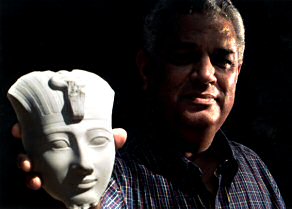
Mohamed Saleh Director Egyptology Unit - The Grand Museum of Egypt Former director of the Egyptian Museum of Cairo
Since he was here visiting San Francisco from June to September of 1979,
he had plenty of free time in the evenings. He became friends with Mary
Ellen, with Ola and the rest of us who hung out at Nicole's
on Sundays studying Egyptian Arabic and the Bagdad became his second
home on the other nights.
Yes! The Bagdad truly was a home away from home for homesick Arabs (and
Egyptians).
I wonder what happened to Mohamed. When I went to Egypt we hung out with
him. He even took us on a private tour of the museum. What an honor! It's
been so many years and I've lost contact. I remember him telling us that
he was probably going to move on and away from the politics of the museum
- I think he did for awhile - like away to Germany. But then he eventually
did come back to oversee the soon to be opened Grand Museum at
Giza. Meanwhile Zahi Hawass took over the Egyptian Museum and
became a big star. But since the January 25 revolution I wonder what has
happened. Is Mohamed still working on the Grand Museum? Is there still
a Grand Museum waiting to open? And Zahi? He quit during the revolution
only to return as?? Where is he now? I only see his reruns of on the archaeology
channel. What condition is the Egyptian Museum in now? It is after all
at the edge of Tahrir Square. Is it surviving all these demonstrations
and millions of people? What about the tons and tons and millions of artifacts
in the museum? Are they trashed? Sold in the Night? I guess that's why
we have the Internet, we can find out almost anything here. I should quit
wondering and find out what happened.
And in the meantime I don't have to wonder about what happened thirty
years ago. Thanks to old age, those memories are like yesterday. I remember
that night at the Belleue very well including my choice of songs as they
were two of my favorite songs at the time...and they still are. I melded
and danced to "Baed Anak"
(Baligh Hamdi/Ma'mun al Shinawi, 1965) with "Sirat
el Hob" (Baligh Hamdi/Morsi Jamil Aziz, 1964) while
slithering on the floor of the stage area doing the now dread "floorwork".
I wonder what I would do today? Certainly "floorwork" is passé',
but Om certainly isn't. She's still in her prime - how I wish I were -
and she will be for years to come, thanks to the many new artists covering
her songs today and thanks to the numerous belly dance CDs called a tribute
to Om etc.
In my LP version, Om speaks the poetry of "Baed Anak" and it
is incredibly moving. This was at a time when dancers except Sohair
Zaki really did not dance to the songs of Om Kalthoum - yet.
It was almost a "no no". There were no belly dance records using
Om at this time. I didn't know that we weren't supposed to because I usually
only performed to the live music at the Bagdad and we always danced to
Om. Never mind that we were only there taking up visual and physical space
on stage so the musicians could do what was really important - and that
was singing their hearts out for the homesick Arabs. What was really not
acceptable dance behavior then seems to be the norm now. So, here I am
30 some years later working on teaching a choreography to a song by Om
Kalthoum.
Baed Anak = away from you
baed - away, far
niseet - forgot
noum - sleep
aHlam - dream
layalli - nights - leil -a night
ayaam - days - youm - a day
Hayaati - my life - the i = my
aazaab - torture, torment
domoua - tears
aHbaab - beloved
shouq, shou' - longing
dawwibni - melt me - ni = me
saharni - kept me awake - ni = me
hayyarni - confused me - ni = me
I hope I'm not giving out too many vocabulary words. Hopefully soon you'll
see that in song talk there really aren't too many words.
However, each genre of songs does have a specific set of words.
Right now we're working on the traditional love songs.
I don't even want to touch on the Shaabi songs. That's a different story.
Home
January 27 2012
"Oud and Food"
Tonight was the "Oud and Food" welcome party for Omar, Aswat's
director. He was with us last spring season but then went back home to
Jordan to work and also be with his family.
Aswat convinced him to come for another season and we were happy to have
him back. Exactly 3 hours after he arrived from Jordan last year he met
the Aswat family and conducted his first rehearsal. Then it was non-stop
rehearsals for 5 straight days because we had a performance scheduled
for weekend after he arrived. He had no time for jetlag. This year, to
make up for it, he was given a week to acclimate himself and visit with
us before getting to work.
We all met at the Melody Cafe for "Oud and Food". I'm
guessing that this cafe that just opened a couple of months ago will be
hosting more Aswat events. Assam, the owner sure knows how to make
interesting dishes and is a great host letting us take over his place
for our
private parties. So far two Aswat parties in less than a week.
Most Aswat parties start and end with the music and songs that we play
in our concerts. This time Husain took the maestro position leaving
Omar to enjoy himself and his jetlag. After we played Om's "Yeshak
Kol el Gamil" to warm up all the instruments including individual
instrumental taqsims, Husain led the Aswat Ensemble in Adaweya's
"Kulu aala Kulu" and soon the entire room was singing
the responses. Well, I don't think that Adaweya's songs will ever make
it to an official Aswat performance, but it seems that as long as Husain
is around it will be the unofficial Aswat song. The percussion section
was in good form with Susu playing fellahi on the tabla and Faisal
accompanying her on the riq. With Hassania on cymbals and Katie,
Najwa and me also banging away on more drums we were able to give
it that loud heavy Egyptian sound that Aswat doesn't like. But this was
a party and not a serious concert so it was OK.
We also were happy to meet new potential singers to Aswat. Hearing one
singer named Maram from Egypt was especially exciting. She sang
a number of songs including "Haramt
Ahebak". Since I have used this song many times in both dance
and drum class and it seems to be a much requested dance song at Pachamama,
I think this song will be the base for tonight's vocabulary words.
Haramt Ahebak (I give up loving you) by Warda Al Gazairia
ma teheb neesh - don't you love me
remember the ma____eesh= a negative
teheb = the love part - hob = love
aieesh = live, life
baad = after - baadein = later
oltoh = you said - olt = said
waHdy = alone - waHedeh = one
west = the middle - west el belad = downtown, middle of town
tariq or tareeh - the way
ma araf sh = I don't know
remember the ma____sh = a negative
araf - to know
ana - I, me
inta - you, m. (don't usually use inti - you, f. - too familiar)
faker - to think Home
January 26, 2012
taht il shibbak
Somewhere in my collection of videos I have
Taheyya dancing to "Taht il Shibbak". It's from a
movie "Laabet el Sitt" (1946). I think I will show some
of it next week. I'll show more than just the dance scene. It's nice to
show a bit of the culture besides just the dancing. Puts it all in context.
Taheyya sure is cute in this dance. And of course, the
Dina/Fatme Serhan version presents quite a different picture of the
song. Their version seems to be the "official" version of both
the song and the dance. That shows the power of the Internet and belly
dance CD sales. And she is a current dancer also. That helps.
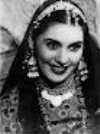
As you can see from the two different clips they are quite different in
mood and presentation. Each dance is performed according to how the song
is sung and the songs are both sung with a different feeling and personality.
And for us, it sure is nice to be able to insert your own personality
into the/a song and make it your own instead of being a clone copy of
another dancer.
One way to do that, besides understanding how the rhythms and instrumentations
affect the mood, is to understand - sort of understand is good enough
- the words of the song. Now, I'm not preaching that you need to study
Arabic and learn to speak, read and write. That would take too long or
a lifetime. (In my case, more than my lifetime.) I mean, just have a working
knowledge of what some of the words mean or refer to...words more than
Habibi and albi and ya aini. It really creates a
deeper knowledge of the song and is the key to dancing like an Egyptian
or an Arab.
In class a couple of years ago I would write key words from songs we were
working on onto a whiteboard. We even went so far as to discuss grammar
and gender. I called this "the blind leading the blind" as I
really am not that well versed in Arabic - only just a mite better than
most of the people in my classes. I did this for about a year and then
for some reason I stopped. Maybe I ran out of words. Maybe I lost interest
as we moved on to other important aspects of the dance. I get like that.
I will fix on something for a while - like "word of the month",
"rhythm of the season", "movement of the year", "song
of the week", "choreography of the night". So, I guess
it's time to again focus on words.
Actually Thursday class reminded me that we used to work on vocabulary
and then I stopped doing it. I think I got discouraged because the class
didn't seem to retain the information. I must remember that Arabic is
a foreign language and it's hard for some (like me) to learn another language.
So, in class tonight I decided I should bring out my whiteboard again
and start writing keywords to the songs we are working on. I will start
this on Saturday. Then it was suggested that in order for the girls to
remember, that I should give homework and see who remembers what. They
suggested that I post the words on my blogs and then do "pop"
quizzes. This sounds pretty good. How do they get rewarded? A gold star?
A jelly bean? A peanut M&M? Licorice? No certifications here - although
some of us may be certifiable. Uh oh, shouldn't have said that.
So with a song like Taht il Shibbak, I will choose key words that may
pop up in other songs and that should be the start of our vocabulary list:
taht -under, down
fo' or foq - up
il - the
shibbak - window
gadaa' - the neighborhood dude who may be a bit tough, but watches out
for everyone's welfare
tu'ulli - you tell me
ba-oll - I tell, say
(ba olek eh=I tell you what-ek=you, f.or ak=you m. eh=what)
bait - house
abous - kiss
boussi - look
uh oh - gotta notice that some words SOUND alike.
dellaa - spoiled girl
ya salaam - a greeting
ana - I or me
haga - something - wala haga=nothing
m------sh = negative as in fee=there is & mafish=there isn't
garrah = wound or surgeon
khadak- your cheek=
remember the ak - not nice to refer to ek or female.
tifaah- apple
OK, I think that's enough for now. I should do this every blog? Speaking
of tifaah, if you get an Arabic for travelers booklet and look at the
shopping section, you will notice under groceries that there is a list
of names of fruit. Check those out and you'll find the equivalent words
for women right there under the words mango, apple, pomegranate, pineapple,
guava, apricot, strawberry. This reminds me that at some point I really
need to get serious about writing my booklet "Song Talk".
Home
January 25, 2012
Cats
About a year ago a scrawny cat appeared on my deck sunning herself. She
looked half dead and could hardly move. Naturally we fed her. She ate
and eventually left. She left only to reappear a couple of months later.
She was still skeletal with matted unhealthy looking fur and an old collar
with no information on it. This time it was raining, so we fed her and
put her in Bob's room to spend the night.
Bob used to be our cat who loved the great outdoors. But because he had
a propensity for owning everyone's backyard and was much smaller than
the neighboring feral cats, he managed to get into enough scrapes that
he was put under house arrest. However, this was not until we built him
an indoor/outdoor room with a wine barrel full of weeds so he could still
enjoy some of the outdoors while being locked down. Since Bob finally
went to the great beyond a couple of years ago, his room has been vacant.
Waiting for a new tenant?
Well, after spending the night protected from the rain, we gave the cat
a choice and she chose to leave. She would, on occasion later come to
visit looking for handouts. And always she was thin as a rail. One time
she came and had a new collar with a phone number. She was still bones
and fur. Gregory called the number and a woman came to pick her
up. As the woman left, cat in arms, Gregory saw the cat push off the woman's
body and dash down the street.

Now it's today, a couple of months later, and when Gregory was watering
the plants in Bob's room he heard some loud meowing and talking and saw
a nose trying to poke its way through the trellis into Bob's room. It
was the cat again. So we gave her more food and spent the afternoon with
her. She is only a few lbs. light and still is just bones and fur. She
immediately devoured 3 and 1/2 cans of kitty food, some kibble, a little
bowl of milk, and some water. She hung out inside and followed us outside
and then followed us back inside and parked herself in front on the food.
Later after Susu finished her drum lesson we were eating a snack
including chicken and the little cat had the equivalent of 1/3 of a chicken
breast and finished it off with the other 1/2 can of food waiting in her
bowl.
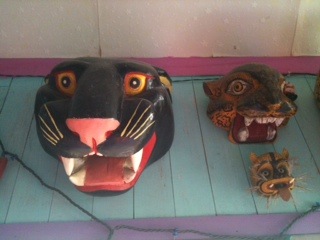


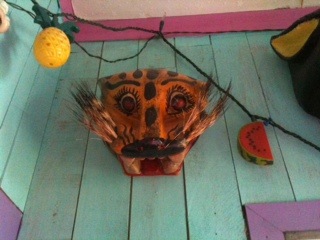
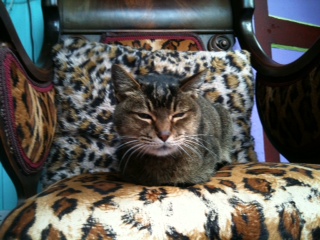
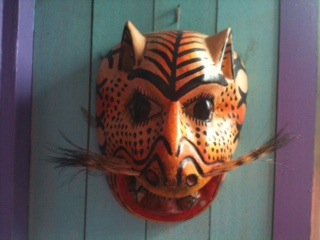
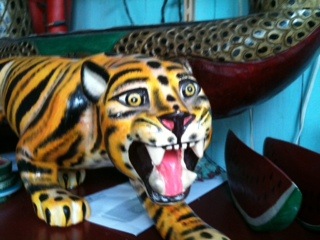

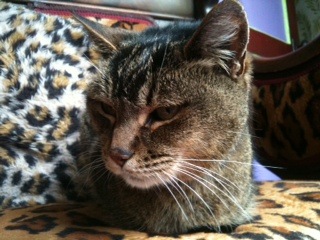
She spent the night, but since it's winter and Bob's room is essentially
an outdoor room and is cold, she spent the night in the Caribbean room
- adjoining Bob's room. It is also known as the watermelon room and the
room with the cat masks. I am sure she felt quite at home with all her
cat relatives. For the time being, I think she needs a lot of R and R
and more food than she seems to be getting in the wild.
What to do? Her "owner" has our number. Home
January 24, 2012
Om Kalthoum the enigma
A couple of years ago Debbie gave me some biographical
song books on Om Kalthoum (1898-1975). One of the books had a CD
disc with 36 one to three minute tracks of Om singing songs starting from
the beginning of her recording career - the 1920's to the 1970's. She
died in 1976.
This CD spans her fifty years of singing from her early qasida or poetry
with hardly any musical accompaniment and no percussion to the large orchestral
sound of her last years. Besides her voice there seems to be one constant
and that is the loyalty of her poets, musicians and composers...namely

Ahmad Rami, (with Om)
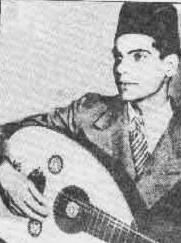
Riad al Sonbati and
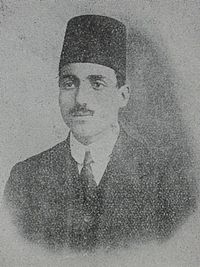 Mohamed
al Qasabji.
Mohamed
al Qasabji.
Although these men may have briefly left her side at times due to hurt feelings, control issues or jealousy, they always returned invigorated and inspired to create even more.
Mohamed al Qasabji (1892-1966)
was involved with Om her entire Cairo singing career until he died ten
years before her. Before he met her, he composed for the Sultana, Monira
al Madeyha and also taught Mohamed Abdel Wahab how to play
the oud. He was such an oud player that people remarked that his body
became molded to his oud and physically deformed him with a hunch in his
back. In 1927 he started composing for Om and although he also composed
for her other rivals such as Asmahan and


Leyla Murad
he was able to remain Om's
favorite composer for 20 years. Because of his type of compositions she
was able to move from singing in nightclubs to the theater stage. Although
he stopped composing for her in 1948, he remained her "main man"
oud player in her orchestra until his death in 1966.
Of the almost 300 songs that Om Kalthoum sang, poet Ahmad Rami (1892-1982)
wrote just about half (137) of them. He started writing for her as early
as 1924 and this song Ya Msaharni
written in 1972 indicates that they had a long lasting (even rumored as
a romantic at times) 50 year working and personal relationship.
Ahmad Rami was also a close friend of Om's biggest threat and rival, Mohamed
Abdel Wahab (1899-1991) and he wrote the lyrics for Abdel Wahab's movie
"The White Rose" (1934). "The White Rose ",
one of Egypt's first talking films was lauded for it's musical sequences
featuring Mohamed Abdel Wahab (1907-1991) and helped kickstart his career.
So, a short time later, Om agreed to star in a movie called "Widad"
(1936) which was the first talking film from Studio Misr.
The lyrics in "Widad" were written by Ahmad Rami and the music
was composed by Riad al Sonbati (1906-1981).
"Ala Balad al Mahboub" a song in the movie, "Widad"
is one of Om's most famous and beloved songs. This is really not a belly
dance song; it's one that you might hear at an Aswat concert. Riad al
Sonbati also had a long standing relationship with Om and composed for
her until the 1970's. "Al Atlal" (1966) composed by Riad al
Sonbati is considered to be one of Om's best songs. Riad, also an oud
player, was greatly influenced by Om's main composer and oud player, Mohamed
al Qasabji. While both composed and played in the traditional Arabic style,
the younger Riad, like his colleague Mohamed Abdel Wahab, dared to introduce
western instruments such as the accordion and rhythms (Latin) to Om's
pieces thereby giving her a more modern and contemporary sound. If you
ever make it to Pachamama where I play with Georges Lammam,
you for sure will recognize a piece that Georges always plays called
Longa Riad (al Sonbati).
Although we may know Om Kalthoum's songs mostly as the ones written by
Mohamed Abdel Wahab, the truth is that Abdel Wahab didn't really start
writing for Om until around the last ten years of her life. It seems that
nationalism and Nasser and Om's touring for Egypt brought them
together and they put aside their decades long rivalries and differences
for the sake of Egypt and art and collaborated with "Inta Omri
"(1964). Some of Abdel Wahab's songs that we know and love are
"Amal Hayati" (1965), "Fakkarooni" (1966),
"Hadthihi Laylati" (1968), "Daret el Ayam"
(1970), "Aghadan alkak" (1971) and "Lailet Hob"
(1972).
So, while listening to the CD that accompanied the Om Kalthoum book I
imagined the men in her life and how her friendships affected her career.
One thing for sure...although I'm only writing about 4 of her men, it
seems that she was able to keep and juggle lasting relationships and collaborations.Home
January 23, 2012
Assuite couture
Today Gregory was passing by Nieman Marcus and saw a dress
in the window that he said was made of assuite. He said it was black with
gold metal designs and that the tulle was backed by a black material.
I wonder. This is inspiring. I often thought about a dress - not a dance
costume - made of assuite. It certainly would look incredibly dashing.
Every once in a while I will see a piece or pieces of assuite draped on
models in fashion magazines but never have I seen a piece used as a "cocktail"
dress for regular wear. I'm sure it's done all the time. And if not, why
not?
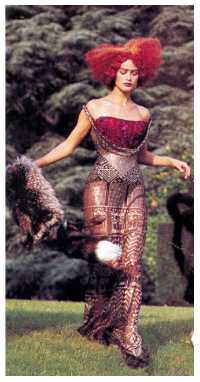
Years ago I cut up a piece and covered a red satin shirt with it. The
shirt wore out but the assuite remained intact, so I removed it from the
shirt. Somewhere in my closet I still have it. It's been years since I
wore that piece of assuite. I guess I never wear it because I feel self-conscious
that people will think I am wearing a dance costume. But I just pulled
it out and looked at it with different eyes. It isn't a costume; it never
was. It's a sleeveless see through top just waiting to be worn. I think
I will start putting it to use and maybe the next time you see me, I'll
be wearing an assuite shirt. I hope it'll be a nice day. The metal in
the tulle is very sensitive to hot and cold. When it's cold, brrrr, it's
cold and if near a heater, yikes it can be the spoon in the glass of tea.
Hot, hot, hot!
Better to wear the assuite than to just keep it carefully folded away
in a drawer.
January 22, 2012
Dancing up a storm
This was the first rainstorm of the season and not exactly weather for
people to go out partying. Well maybe not for most people, but there's
nothing more fun for a dancer than to be dancing up a storm in an Egyptian
restaurant.
Yes, there was a dancers' night at Al Masri tonight. With the rain
pending I was wondering why I was even going. But since it was MY night
and I had arranged it, I guess it would've been bad if I didn't show.
Inertia was hitting big time especially since it was so warm and cozy
at home, but duty called! Everyone has an "old shoe" comfortable
costume, so I pulled mine out, stuffed it in a bag along with a CD and
headed out the door. On the way to Al Masri I reflected on all the times
at the Bagdad when we would literally lock the door of the club
- with the customers in it - and tell them that since it was raining they
had to stay and enjoy our show. Checking the inclement weather, they would
stay and would stay all night and then some. Those were usually some of
our most fun nights...a quiet kind of energy with people wanting to weather
the storm with a belly dance show. This is what tonight was like. Eleven
dancers, all you can eat food and dessert, great entertainment and hanging
out after the show - not wanting to leave - just wanting to hang out and
discuss various issues relating to the business of dance and art.
I spent a little time bemoaning my computer and web problems complaining
to anyone who would listen to me. But that gets old after a while and
in reality is not really important...not even to me. But, if you've wondered
why lately my blogs seems to be inconsistently posted, that is why.
Dan, a friend of Rebecca's told us of his plans to start
an art salon. He wants us to precede the salon by running about 5 miles.
This way we can exercise and then relax and soothe the mind, the psyche
and the body by discussing art and writing. Sounds like a wonderful idea.
But running? Maybe dancing would be more fitting or fun. At least more
fun for me.
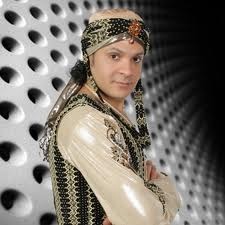
Next month there will be an Egyptian dancer and teacher, Mohamed Shahin,
teaching in a workshop sponsored by Sausan of Al Masri and I heard
that there is still plenty of room.
While talking about this workshop we also discussed the issue of workshops
in general and wondered why some of the best and most sought after dancers
don't do well in this area.
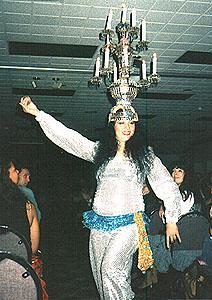
I thought about the Egyptian dancer Nadia Hamdi. The last workshop
she taught here had probably 30 people in it.
That sounded pretty successful to me, but then I discovered that in other
areas - the East Coast, the Midwest and Northwest, she had up to and over
a hundred. There have been many, many dancers of worth who seem to draw
in other areas but not here in the SF Bay Area. Why? It doesn't even seem
to be about the price as some of these workshops are very reasonably priced.
I recently went to a workshop with a dancer from Egypt and there were
only 8 people. That is a real shame. And this was not the first time that
a dancer from Egypt was here and drew less than 10. Why????
I may be a dance teacher myself, but there is always room to learn more
or to get more and new inspiration. I wonder why we in this area don't
really go to workshops. For sure that must be why Little Egypt
never brings Dina, Randa and other big stars to San Francisco.
This seems to be a nowhere town for dance workshops and then we gripe
because we have to fly to other places to study with these great teachers.
The only person who seems to have a bit of success in bringing foreign
teachers here is Hala, but I am sure that she, too, is disappointed
with the interest and attendance. I don't think we're over saturated with
workshop teachers. But I do think that if we spent as much money on taking
workshops with reputable teachers as we do on costumes, that we'd be better
off.
I'm reminded of a dancer? I met once who had a $1,000+ costume and wanted
to start performing after taking 4 lessons.
Sad thing is, she did find work.
January 21, 2012
Band Practice and Tarabiya
It was pretty exciting today. We had our first band practice of the year.
Jalal, Susu, Husain, Younes and me. In anticipation, I had a few
drinks and snacks set out and

Husain also brought some felafel and yoghurt, but we were all so anxious to get to practicing, nothing was touched.
We had decided that we would make a list of songs that we all know and
set the arrangements for the different instruments. While tuning up/warming
up, Jalal started doodling around on the kanun and soon we were learning
beautiful new old songs. They were so old, he, Jalal, had even forgotten
their names. So they were given new names such as "Turkish bolero",
"Armenian Turkish bolero", "the one with the drum breaks",
"Old Greek in Nahawand do" (as is do re me fa sol) and "the
one from that record" . All these names were duly recorded in my
set list notebook for future reference. It sounds dumb, but it really
works in identifying various pieces and is more efficient than just humming
the tunes or rhythms prior to playing. Those names reminded me of the
names we used for Susu's drum solos: "new drum solo", "new
new drum solo", "old new drum solo", "new old drum
solo", "bambi drum solo with maqsoum". I guess when Susu
and I next meet to work on her "next new drum solo" CD, we will
soon come up with names such as "libi with a twist", "fast
ayoub" and so on. But now, back to our new old songs.
Our new old songs are great because we will be able to use them when we
play for dancers and finally some of the noodling around taqsims will
actually have structure and arrangements with specified instrumental solos
and there will be a beginning, middle and end.
One of my jobs is to find recordings and compile a "to learn"
CD. I'm pretty lucky that I have an extensive collection of LPs and cassettes,
because a lot of the music we will be using is old music not available
on CDs. We already have a good selection of the old favorites and even
have figured out arrangements, but we want to add more songs to our repertory.
What better place to look for the new, but in the past. I think I already
touched on that subject before in previous blogs.
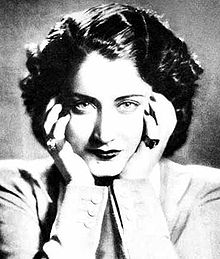
We will be using songs from Asmahan,

Abdel Wahab (of course),

Faiza Ahmed and more. The more is the fact that we are musicians from various backgrounds having extensive knowledge of Turkish, Persian, Moroccan and North African, Egyptian, Arabic including Iraqi and Gulf, Belly Dance and even Shaabi (Moroccan and Egyptian) music and want to be learn it all and be inclusive. This should be a pretty ambitious but doable project since the common desire is to create music for people to listen to, dance along to and also belly dance to.
We are hoping to get a couple of more musicians on board to make our sound
more complete...probably Faisal, maybe a couple of others. In the meantime
we'll keep plugging along. Since this all started with Tarabiya
last October, we realized we wanted to continue practicing and officially
become a band. Although Susu didn't take part in Tarabiya because she
was in Minneapolis playing with the Lammams and Karim Nagi
for Cassandra's annual show, she was in on the original Tarabiya
plans. Among our projects for 2012 will be a demo recording and another
Tarabiya type show at the Mission Cultural Center for Latino Arts
(but with a different theme).
For now, my homework is to scout for old recordings and find and compile
new old music. Meanwhile, some of us will be at Al Masri on February 5.
Hope to see you there in the audience or the dance floor.
January 20, 2012
Sitting with customers
I've been thinking a lot about a paragraph I read in the
book "Asmahan's Secrets"
by
Sherifa Zuhur. 
"The artist cannot usually exist on the income from his or her
art without a patron, but that patron exacts a price. The song, the composition,
the poem, the work must often be written with the patron in mind, thus
limiting and delineating the activity and the creativity of the artist.
In a nightclub context and at private or even public party performances,
the artist is expected to lift the spirits of the patron, even when offstage.
The patron may reward the performer through tipping, through future engagements,
or through gifts. Conservative Arabs bemoan not only the behavior of the
performer but that of the patron as well, who loses control of himself
through enjoyment of the music--that is through its tarab and who may
throw money lavishly to demonstrate his enjoyment. Vices related to the
entertainment world such as drinking, drugs and gambling are also a problem
due to their proximity."
 I think about the "cafe society" or the "beautiful people"
who would gather in cafes and restaurants in Paris, London or other cosmopolitan
large cities in the early 1900's. And then I think about the casinos and
salas in Cairo around Ezbekiya Park and Emad el Din Street and I wonder
about Cairo's "beautiful people". When I imagine those "beautiful
people", the men in their suits, their tarbooshes and walking sticks,
the women in their fancy French silk couture gowns, furs (yes, even in
Cairo), heels and finely coiffed hair, I imagine the days of Farid,
Asmahan, Mohamed Abdel Wahab, and King Farouq. I imagine elaborate
dinner parties in villas as well as the salas around Opera Square. And
always there is entertainment. In the salas there may have been revues
with multiple dancers, but there were always singers just as seen in the
Egyptian black and white movies. There was Mohamed Abdel Wahab, Farid,
Asmahan, Karim Mahmoud and more. Maybe there was even Om Kalthoum.
Yes, even the great diva sang in clubs around Opera Square.
I think about the "cafe society" or the "beautiful people"
who would gather in cafes and restaurants in Paris, London or other cosmopolitan
large cities in the early 1900's. And then I think about the casinos and
salas in Cairo around Ezbekiya Park and Emad el Din Street and I wonder
about Cairo's "beautiful people". When I imagine those "beautiful
people", the men in their suits, their tarbooshes and walking sticks,
the women in their fancy French silk couture gowns, furs (yes, even in
Cairo), heels and finely coiffed hair, I imagine the days of Farid,
Asmahan, Mohamed Abdel Wahab, and King Farouq. I imagine elaborate
dinner parties in villas as well as the salas around Opera Square. And
always there is entertainment. In the salas there may have been revues
with multiple dancers, but there were always singers just as seen in the
Egyptian black and white movies. There was Mohamed Abdel Wahab, Farid,
Asmahan, Karim Mahmoud and more. Maybe there was even Om Kalthoum.
Yes, even the great diva sang in clubs around Opera Square.
Those days when the "beautiful people" were listening to Django
Reinhardt, Billie Holliday and Lena Horn in Europe and America,
Cairo's "beautiful people" were listening to the tangos of Asmahan
and Farid. Abdel Wahab, Asmahan, Farid, Mohamed Fawzi, all the
singers and composers in those clubs embraced the European sounds while
also maintaining their Arab traditions.
As I mentioned above, artists can't always live without patrons and these
artists, Abdel Wahab, Farid and Asmahan fell into this category. "Sitting
with the customers". And yes, there was drinking, smoking and gambling
as well since these were cosmopolitan times. Cairo was a very different
city than it is now. It was a party town and the Kingdom enjoyed its parties.
Asmahan, was a new and up and coming threat to Om's kingdom as she was
younger and considered more beautiful. Although she had an incredible
voice, it was often inferred
that she was hired for other than her voice.
As in Om's case, where
 Asmahan actually had a more versatile voice than Om as she was both Western
and Eastern trained, I wonder just how much of the talk was just malicious
talk. In this you tube clip,
you can hear Asmahan singing a song originally composed for and rejected
by Om because Om's voice was not suitable for a Western passage in the
song. As a result of Asmahan inheriting this song composed by Muhammed
el Qasabji who played in Om's orchestra, Qasabji seemed to have been
ousted from Om's favor. I guess that's what happens when there's a new
kid on the block and she also has talent. The older artist may have a
fit and sometimes there are repercussions for all involved.
Asmahan actually had a more versatile voice than Om as she was both Western
and Eastern trained, I wonder just how much of the talk was just malicious
talk. In this you tube clip,
you can hear Asmahan singing a song originally composed for and rejected
by Om because Om's voice was not suitable for a Western passage in the
song. As a result of Asmahan inheriting this song composed by Muhammed
el Qasabji who played in Om's orchestra, Qasabji seemed to have been
ousted from Om's favor. I guess that's what happens when there's a new
kid on the block and she also has talent. The older artist may have a
fit and sometimes there are repercussions for all involved.
Doesn't that sound familiar? Well, maybe Asmahan didn't have to "sit
with the customers" anymore, but at what price? I'll delve more on
Asmahan in future blog. Home
January 19, 2012
Back to default
Every dancer has a back-up or rest step whether or not he/she knows it.
When I first started dancing, my rest step was step hip. Actually, at
that time, aside from circles and figure 8's, the only other step I knew
was step hip. I guess I've come a long way and learned how to simplify
that most simple step, step hip. Now my simple rest step, my default step
is just that, a step minus the hip. Yes, just step onto the stage and
simply walk.
Soon after I started performing at the Bagdad, Yousef, my boss,
made a deal with me. He would give me a raise if I took more dance lessons.
So I did. I took a private lesson from Bert since my teacher; Bettina
Robbi wasn't living in San Francisco any more. I had met Bert at
the Bagdad and found that we were neighbors. At that time
Bert lived in San Francisco walking distance from my house and he
taught classes in a garden level dance studio. Think about inflation...I
paid $5 for my private lesson. He taught me to walk. He said it was about
attitude and entering the stage like a star.
That was $5 well spent. I still remember and use what he taught me today
and when I need to take a breather in my dance, why, I just walk.
Tonight in performance class we walked. Walking with an attitude can be
quite powerful. Last week when Outi was teaching her workshop I
was reminded of how powerful walking can be. She didn't talk about just
walking; she talked about attitude in an entrance and then she demonstrated.
And what did she do? She walked and strutted and nothing more.
Of course it was to the music, but it was just a walk. The entrance does
not have to be much if done with the correct attitude. Lots of intricate
steps and shimmies while entering are just wasted steps. They should be
saved for later.
Another great entrance example is on a video I have of Dina. 
She did
a number of dances and costume changes, so she did a number of entrances.
I really enjoy showing her entrances to the class. OK, I'll admit she
doesn't walk or strut - she RUNS!
How's that for simplicity and attitude?
So in class we talked about default steps. These are steps one does when
the mind or body goes blank when dancing. Because I have become comfortable
with walking in performance, and see what it is capable of accomplishing
in the dance, my default is just to step, to walk. It's simple and falls
in the category of "less is more".
Simple default steps are what mashed potatoes or rice are in a special
dish. They really aren't anything, but are oh so important and necessary
to showcase the rest of your dance. Two movements that should not be default
steps are spins and shimmies. Too much spinning or too many shimmies can
just make the dance look busy or can even create nervous energy. It is
much better to just choose a default movement that is simple. Then when
you do that special spin or shimmy it will look and be special. Home
January 18, 2012
The Magician's Assistant
Tonight I got together with Susu and we listened to drum solos
on various CDs. She is planning on making another CD and wanted to brainstorm
on what to put on her next CD. We mostly discussed the length of the solos
and the tempos. Then we got to work. Or maybe I should say and then the
fun began and we played!

Of course I just did what I do best - played back up while Susu played
and improvised. I recorded what she did, we listened and analyzed what
was recorded and then I danced the solos imagining what other dancers
would do.
This is really a fun project. I will make a CD of what we did and listen
and dance to it even more. I am sure that by the time we finish this project,
that I will have enough out-takes for numerous CDs.
Since I can only play a drum solo by either following a CD drum solo or
by playing along with another drummer - I've only done this with Susu
and
 with
Loay
with
Loay
- I wonder what goes on in the drummer's head when creating a drum solo. When I dance, I follow - whether it's the rhythm, the music, the instruments or the lyrics - I follow and then I, or my body, decide how to choreograph or when to be spontaneous. And when I play percussion to music, I still follow and also can decide or know when to improvise or when to just stay with the beat.
But a drum solo? That's like a taqsim, an improvisation. How does one
conjure up what to do? What to play? It's beyond me.
Most drummers will start with 4 maqsoums. That allows them to think or
get started. I think I would start with 4 maqsoums and then continue playing
maqsoum. I really don't know if I could get beyond the start phase. I
know that one has to start somewhere and get beyond the basic rhythm.
I suppose that somewhere is to play a memorized already composed drum
solo. But how to leave that composition and make one of your own is really
beyond me. It's weird. When I accompany the drum on cymbals, it's amazing
that I can lock into the drum patterns and play (simultaneously or even
before) what the drummer will play. But to be the drummer and know what
riffs to play and in what order is beyond me. That is magic. That is creating
magic. Someday I, too, want to be a magician. But it's also great fun
just being the magician's assistant.Home

Carnival of Stars Belly Dance Queen
829 Elizabeth Street
San Francisco, CA 94114
(415) 282-7910 aminajune@aol.com
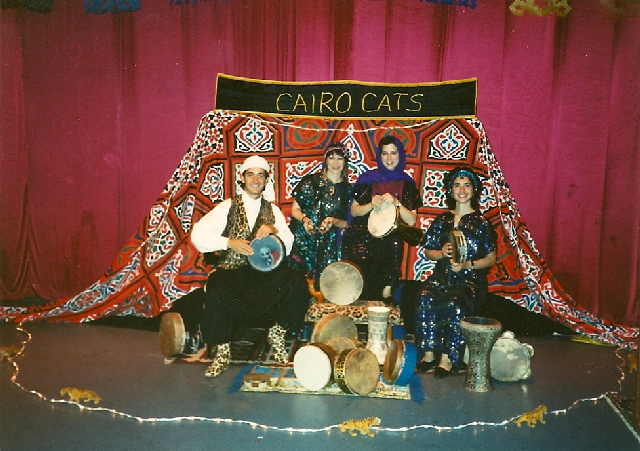
Cairo Cats in Lobby of Ethnic Dance Festival
Gregangelo, Amina, Susu and Daria
